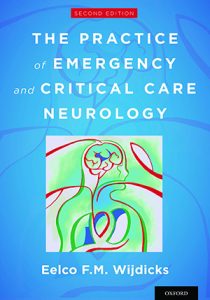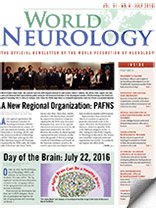By Katharina M. Busl, MD, MS
 This is a comprehensive, extremely well-written, single-author textbook on emergency and critical care neurology by one of the most renowned, experienced, published, and respected neurointensivists. In his preface to this second edition, the author outlines his intention for this book to serve as a practical and data-driven guide to management of the critically ill neurological patient, rather than a textbook detailing theory. This is exactly how I perceived this book. It is organized into 12 chapters that include a symptoms-based approach, organizational aspects, general critical care aspects, and management of specific disorders, complications, or consultation situations. Some of the chapters are geared more toward the neurologist assessing emergent consultation, some to the neurologist or neurointensivist managing the specific neurocritical disorders, and some to the neurointensivist or critical care physician staffing an intensive care unit. Complex topics and concepts are presented in a clear and concise manner, and enhanced by plenty of original illustrations and imaging examples. The text is supported by available, up-to-date data, as well as the vast clinical experience of the author himself. Sensitive topics, such as end-of-life discussions or ethical dilemmas, are addressed with vision and care. The statements are clear with virtually no redundancy or ambiguity. Flow is excellent, and style and organization allow for both rapid, continuous reading, as well as rapid look-up.
This is a comprehensive, extremely well-written, single-author textbook on emergency and critical care neurology by one of the most renowned, experienced, published, and respected neurointensivists. In his preface to this second edition, the author outlines his intention for this book to serve as a practical and data-driven guide to management of the critically ill neurological patient, rather than a textbook detailing theory. This is exactly how I perceived this book. It is organized into 12 chapters that include a symptoms-based approach, organizational aspects, general critical care aspects, and management of specific disorders, complications, or consultation situations. Some of the chapters are geared more toward the neurologist assessing emergent consultation, some to the neurologist or neurointensivist managing the specific neurocritical disorders, and some to the neurointensivist or critical care physician staffing an intensive care unit. Complex topics and concepts are presented in a clear and concise manner, and enhanced by plenty of original illustrations and imaging examples. The text is supported by available, up-to-date data, as well as the vast clinical experience of the author himself. Sensitive topics, such as end-of-life discussions or ethical dilemmas, are addressed with vision and care. The statements are clear with virtually no redundancy or ambiguity. Flow is excellent, and style and organization allow for both rapid, continuous reading, as well as rapid look-up.

KATHARINA M. BUSL, MD, MS
There are very few minor aspects that could be mentioned critically. The chapter on critical care support appears rather truncated, which is understandable given the breadth of these topics. However, a more specific link to the neurological patient could possibly have been made. Similarly, the chapter addressing systemic complications touches only little on dilemmas in the neurological critically ill patient, such as gastrointestinal bleeding in patients who require antiplatelet medications, or pulmonary embolism in patients with intracerebral hemorrhage. However, the author acknowledges the biggest problem — absence of data for the neurocritical care population. Furthermore, a chapter on critical illness myopathy or neuropathy, a problem often addressed in the general critical care literature, but paid less attention to in the neurocritical care population, could have completed the chapter on complications.
The textbook comes with a handy pocket book (in print or mobile device version) that contains a selection of the most relevant tables and figures and a compilation of practical notes.
In summary, this book is very impressive in its composition, scope, and style. I wholeheartedly recommend this wonderful book for any clinician primarily caring for critically ill neurological patients, specifically for practicing neurointensivists and neurocritical care fellows. In the larger scheme, it is also of interest to any neurologist or physician of other specialty consulting on critically ill neurological patients.
